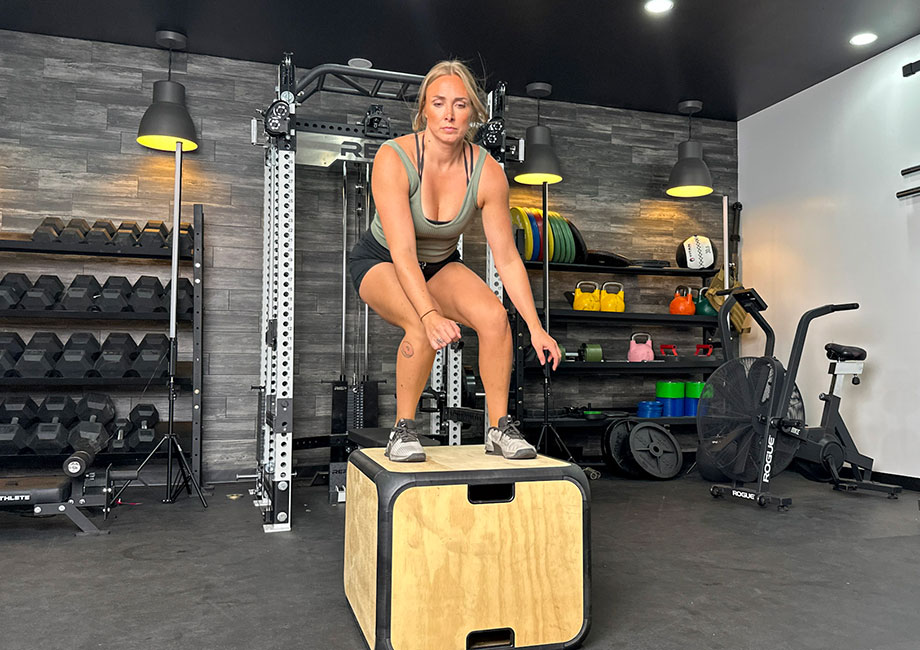We test and review fitness products based on an independent, multi-point methodology. If you use our links to purchase something, we may earn a commission. Read our disclosures.
Explosive workouts benefit a wide range of individuals, not just athletes. Whether you’re a weekend warrior, a parent enjoying active playtime with your child in the backyard, a dedicated gym-goer aiming to conquer your next training milestone, or simply someone seeking to enhance your athletic performance, these workouts can be a fantastic tool for your fitness journey.
As a certified performance coach with a CSCS certification and years of experience, I consistently design explosive workouts for my personal training clients and sports performance athletes. I do this because I believe in the advantages they can gain from such workouts.
RELATED: How to Do the Kettlebell Clean for Explosive Strength and Power
Keep reading as I dive deeper into my favorite movements for explosive strength that you should try in your next workout to develop speed, power, and strength.
Explosive Workouts: Power vs Strength
Explosive exercises require you to produce high rates of force in short amounts of time. These movement patterns can improve your speed and power by enhancing your strength, jumping, sprinting, and changing direction abilities1 in and outside the gym.
The two key differences between power and strength are the amount of weight being lifted (light vs. heavy) and the speed at which the movement is performed (faster vs. slower). Think of the speed at which you jump and then squat with moderate-heavy to heavy loads to understand the difference. This is what separates explosive movements from strength exercises.
RELATED: Types of Strength Training
Box Jump
Why do it: Snag one of the best plyo boxes and let box jumps train you to be explosive and improve power in the lower body, helping you jump higher and enhance athletic performance. Box jumps are one of the best bodyweight plyometrics exercises to program in your workouts.
Not sure where to start? Try one of these box jump workouts!
How to do it:
- Stand about a foot away from a plyo box (or bench) with your arms overhead.
- Perform a quick quarter squat while swinging your arms down for momentum.
- Explode up while swinging your arms and land softly in a quarter squat on top of the box or bench.
- Step down and repeat as needed.
Expert power tip: Focus on the height of your jump, not the height of the box you are jumping on.
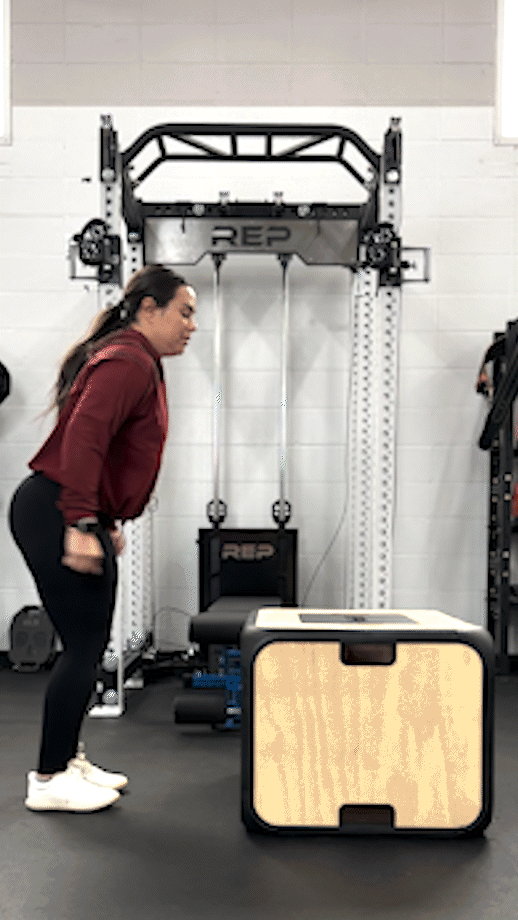
Broad Jump
Why do it: Broad jumps train explosiveness in a horizontal direction, relying on powerful hip extension. Where box jumps allow you to be powerful when driving up, broad jumps develop power as you drive out. A simple way to program them is to have a vertical power day (e.g. box jumps or tuck jumps) and use broad jumps on your horizontal power days.
How to do it:
- Stand tall with your arms straight overhead.
- Swing your arms down fast as you enter a quarter squat.
- Explode out, driving your body forward.
- Land softly and balanced with your feet under your hips in a high squat.
- Repeat for desired reps.
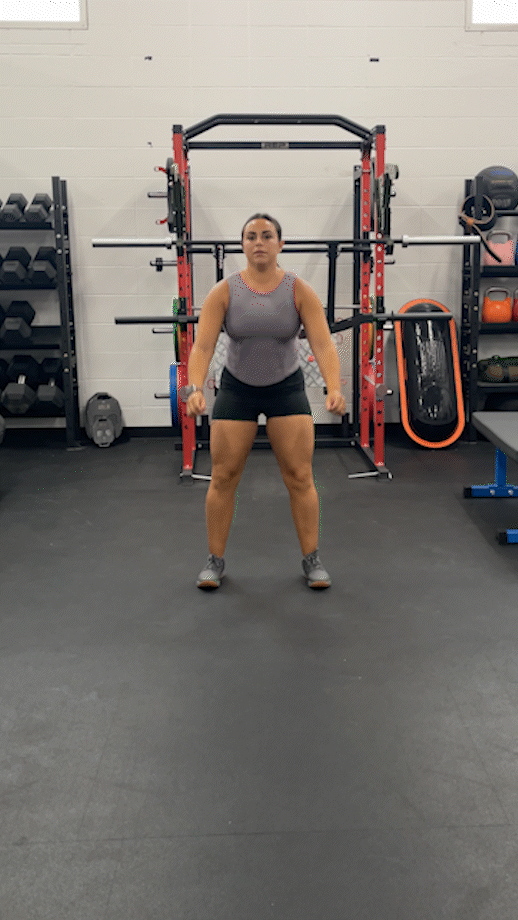
Tuck Jump
Why do it: Tuck jumps are an agility exercise that helps enhance power, athletic performance, and calorie burn in HIIT workouts. This movement builds explosiveness, similar to box jumps, but the key difference is the need for force absorption as you land.
How to do it:
- Stand tall with your arms overhead.
- Swing your arms down as you drop into a quarter squat.
- Explode straight up and out of the squat position, swinging your arms up and tucking your knees into your chest at the top of the movement.
- Land softly in a balanced squat position.
- Repeat for desired reps.
Expert power tip: Use squat jumps as a progression to tuck jumps, and make sure you practice proper landing mechanics.
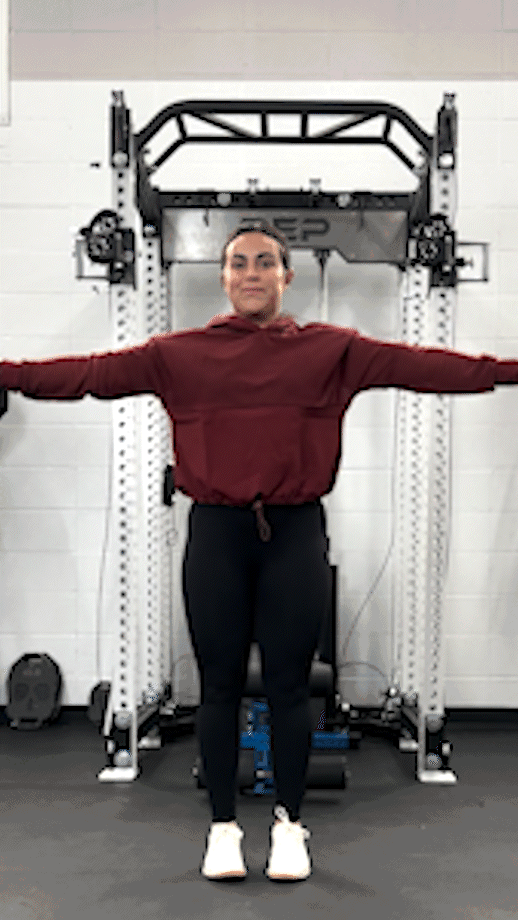
Kettlebell Swings
Why do it: Kettlebell swings offer a versatile option that fits well into any part of your workout as you develop strength and explosive power in the posterior chain, targeting the glutes and hamstrings. Use them at the beginning of a workout to warm up for deadlifts, as a hinge-focused strength movement, or pair them with a tabata timer for cardio.
How to do it:
- Place your feet shoulder-width apart and hold the kettlebell with an overhand grip. The kettlebell should start right below your hips.
- Brace your core and unlock your knees slightly.
- Hinge your hips back and allow your torso to come forward.
- Drive your hips forward, swinging the kettlebell with straight arms to around chest height.
- As the kettlebell swings back, hinge your hips.
- Repeat for desired reps.
RELATED: Best Kettlebells
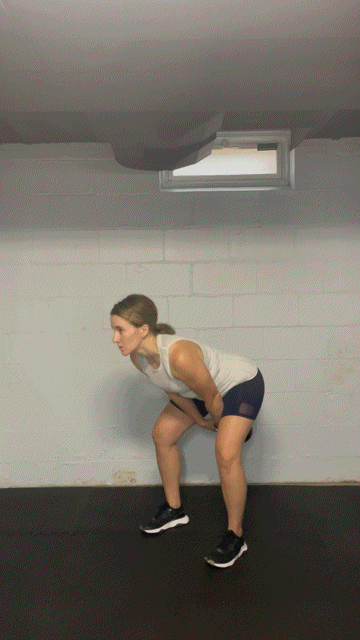
Kettlebell Push Press
Why do it: I love to include this movement in my training programs for athletes and clients in their push-pull workouts. It helps develop full-body power, with a particular focus on the upper body, and the momentum you get by driving with the legs allows you to lift more weight. You have to give this exercise a try if you want to get the most out of your explosive workouts.
How to do it:
- Stand with your feet hip-width apart, core tight, and back flat.
- Lift or clean the kettlebell to your shoulder.
- Grip the handle as the kettlebell rests on the pressing arm.
- Dip slightly with the knees pointed slightly out.
- Drive with the legs out of the dip and PUSH the kettlebell overhead.
- Once locked out, slowly lower the weight back to the start position.
- Repeat for desired reps.
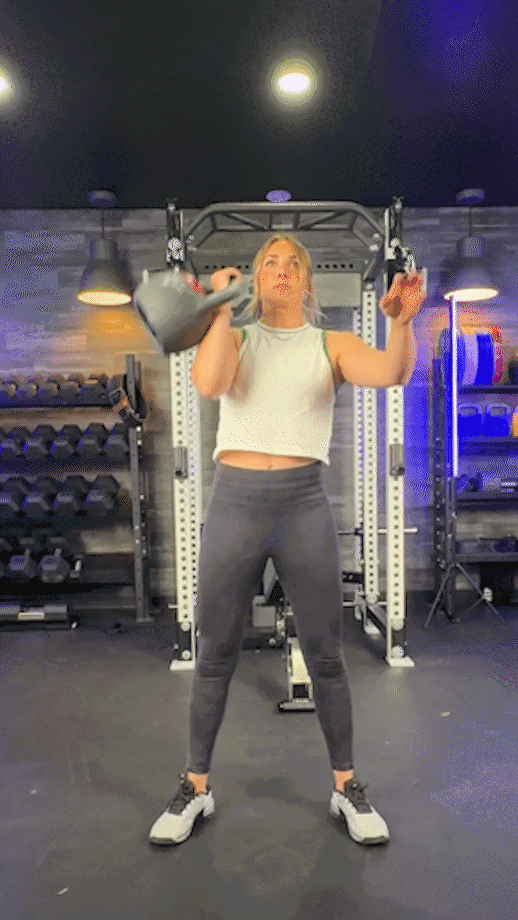
Kettlebell High Pull
Why do it: A kettlebell high pull is a go-to movement for explosive training and serves as a teaching progression for powerful kettlebell exercises such as the kettlebell snatch and clean. If you’re newer to kettlebell training, make this a staple for any beginner kettlebell workout.
How to do it:
- Position your feet hip-width apart.
- Place a kettlebell between your feet and grab it with an overhand grip.
- Drive with your legs and extend your hips straight up.
- Once the weight reaches the upper thigh, pull the kettlebell to chest height with your arms.
- Lower the weight with control back to the start position.
- Repeat for desired reps.
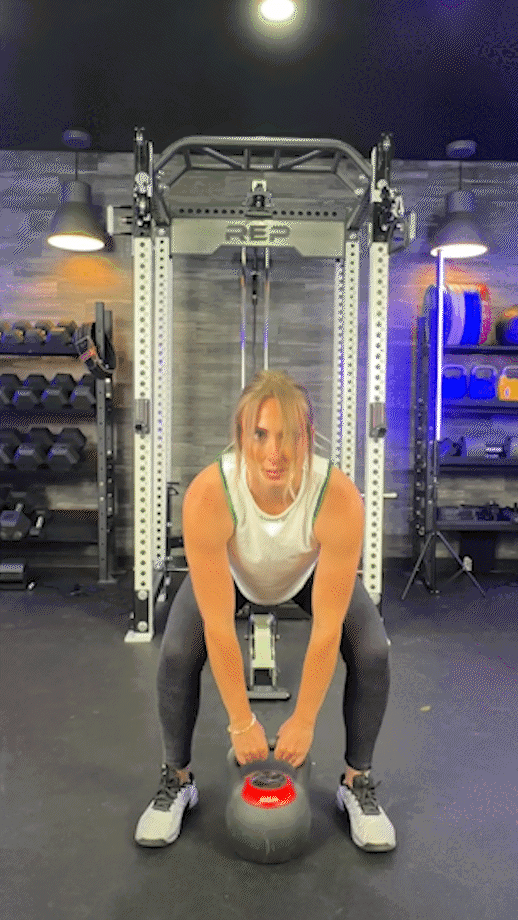
Kettlebell Clean
Why do it: The kettlebell clean delivers the power-building advantages of Olympic barbell exercises while being easier to master. This exercise primarily works on explosively extending the legs and hips, simultaneously demanding strength from the lower and upper body and promoting core stability.
How to do it:
- Place a kettlebell in front of you.
- Stand with your feet hip-width apart.
- Squat down to grab the kettlebell, keeping your back flat, core braced, and working arm straight.
- Grasp the kettlebell with your right hand using an overhand grip.
- Use your legs to explode up, drive your hips, and pull the kettlebell up with your right arm.
- When the kettlebell reaches chest height, flip your hand and tuck your elbow into the catch position. The catch position should have your wrist straight, arm vertical, palm forward, and weight stacked above the elbow.
- Slowly lower the kettlebell back to the floor.
- Repeat for desired reps.
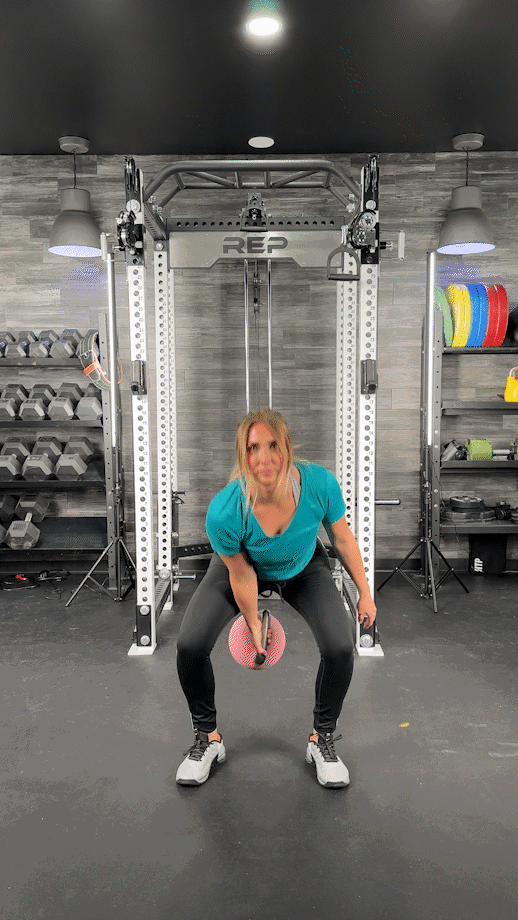
Kettlebell Snatch
Why do it: The kettlebell snatch is an explosive bang for your buck exercise. I use it with clients and athletes to improve overall power output by working on major muscle groups such as the quads, hips, shoulders, and core. Additionally, it places a significant emphasis on building upper body strength and stability, particularly in the overhead position where you have to hold the kettlebell.
How to do it:
- Place a kettlebell in front of you.
- Stand with your feet hip-width apart.
- Squat down to grab the kettlebell, keeping your back flat, core braced, and working arm straight.
- Grasp the kettlebell with your right hand using an overhand grip.
- Use your legs to explode up, drive your hips, and pull the kettlebell up with your right arm.
- Once the kettlebell passes the shoulder, punch up into the weight to lock the kettlebell out overhead. The lockout should have the wrist, elbow, and shoulder stacked on top of one another in a straight line.
- Slowly lower the kettlebell back to the floor.
- Repeat for desired reps.
Expert power tip: Incorporate kettlebell snatches and cleans as a warm-up to prepare for barbell weightlifting sessions.
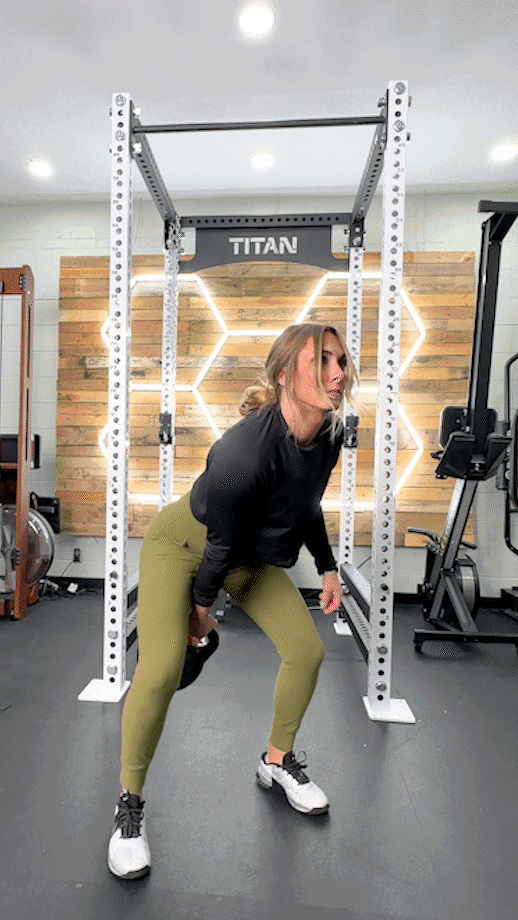
Create An Explosive Workout
I’ve put together a workout combining bodyweight plyometrics with weighted exercises to enhance your explosive power, helping you develop speed, strength, and muscle.
| Movement | Sets | Repetitions |
| Broad Jump | 4 | 3 |
| Kettlebell Clean | 6 | 3 |
| Kettlebell Push Press | 4 | 5 |
| Kettlebell Swing | 4 | 5 |
Explosive Workouts: Final Thoughts
Explosive exercises can help you develop speed, power, and strength for your athletic (and otherwise) performance, especially when it comes to mastering more complicated lifts. They’re also excellent for building agility and stamina, which is something you may overlook when strictly training for gains.
As a certified strength and conditioning specialist (CSCS), I often guide my clients through explosive workouts to help improve their athletic performance. You don’t have to be a professional athlete to benefit from this type of training, either. I challenge you to add an explosive workout—like the one I’ve provided above—into your regular training routine. You might be surprised by how it boosts your PRs.
Get after it!
Explosive Workouts: FAQs
What exercises increase explosiveness?
Many workout movements can develop explosiveness when executed properly. The key is to work within the recommended percentage of your one-rep max (1RM)2 and focus on the movement speed. If you aim to boost lower body explosiveness, consider incorporating plyometric exercises such as box jumps, broad jumps, tuck jumps, or other vertical jump variations into your workout routine.
Additionally, exercises like kettlebell cleans and snatches are effective options. For upper body explosiveness, kettlebell high pulls and push presses are excellent choices for your workouts.
How many reps for explosive power?
The ideal rep range for explosive exercises is 1 to 3 repetitions per set. You can extend it up to 5 reps while maintaining the necessary speed for power development.
Take it from me—a certified strength and conditioning specialist (CSCS)—it’s crucial to allow yourself 2 to 4 minutes of rest between sets to ensure optimal recovery, and aim to perform a total of 3 to 5 working sets for the best results.
How can I increase my speed and power?
To be fast, you need to train fast. The same can be said about training for power. Add a few of the best exercises like box jumps, kettlebell swings, push presses, and cleans to develop speed and explosiveness. Use light to moderate loads emphasizing intent, stay in the appropriate rep range (1 to 5 repetitions) per set, and execute proper form to get the most out of power exercises.
Does lifting heavy increase explosiveness?
Heavy resistance training can be beneficial for developing power output if used correctly. Lifting heavy weights establishes a solid foundation of strength, which is crucial for performance. However, it’s important to recognize that there is a point of diminishing returns with heavy resistance training.
If your goal is to improve explosiveness, you must incorporate explosive training into your regimen. A strategic approach is to engage in a phase of strength training before transitioning to a phase of explosive training.
References
- Cormier P1, Freitas TT1, Rubio-Arias JA2, Alcaraz PE1,2. Complex and Contrast Training: Does Strength and Power Training Sequence Affect Performance-Based Adaptations in Team Sports? A Systematic Review and Meta-analysis. J Strength Cond Res. 2020 May;34(5):1461-1479. doi: 10.1519/JSC.0000000000003493.
- Thomas GA, Kraemer WJ, Spiering BA, Volek JS, Anderson JM, Maresh CM. Maximal power at different percentages of one repetition maximum: influence of resistance and gender. J Strength Cond Res. 2007;21(2):336-342. doi:10.1519/R-55001.1
Further reading

We’re taking a first look at the latest product release from Aviron. Spoiler alert: It’s not a new rowing machine. Find more details in our Aviron Bike review. Read more

What muscles do push ups work? We’re dishing out facts to determine what muscle groups get targeted most during this excellent bodyweight exercise! Read more

Explosive workouts benefit a wide range of individuals, not just athletes. Whether you’re a weekend warrior, a parent enjoying active playtime with your child in the backyard, a dedicated gym-goer aiming to conquer your next training milestone, or simply someone seeking to enhance your athletic performance, these workouts can be a fantastic tool for your fitness journey.As a certified performance coach with a CSCS certification and years of experience, I consistently design explosive workouts for my personal training clients and sports performance athletes. » Read more about: Try These Explosive Workouts for Improved Speed, Agility, and Strength » Read more

Discover the best bodyweight back exercises to add to your workout routine to build strength and minimize your risk of injury. Read more

